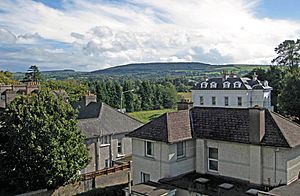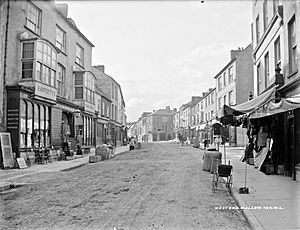Mallow, County Cork facts for kids
Quick facts for kids
Mallow
Mala (Irish)
|
|
|---|---|
|
Town
|
|

Main Street, Mallow, featuring the clockhouse and the junction of Spa Road and Bridge Street
|
|
| Motto(s):
Latin: Per Ignem et Aquam (Through Fire and Water)
|
|
| Country | Ireland |
| Province | Munster |
| County | Cork |
| Area | |
| • Urban | 8.2 km2 (3.2 sq mi) |
| Elevation | 74 m (243 ft) |
| Population
(2022)
|
|
| • Town | 13,456 |
| • Density | 1,517.9/km2 (3,931/sq mi) |
| Time zone | UTC±0 (WET) |
| • Summer (DST) | UTC+1 (IST) |
| Eircode routing key |
P51
|
| Telephone area code | +353(0)22 |
| Irish Grid Reference | W549982 |
Mallow (pronounced 'mæloʊ') is a town in County Cork, Ireland. It is about 35 kilometres (22 miles) north of Cork city. Mallow is also the name of the townland and civil parish it is in. It is part of the barony of Fermoy.
Mallow is an important centre for northern County Cork. The main offices for the Northern Division of Cork County Council are located here. Since 2023, Mallow has been part of the Cork North-Central Dáil constituency.
Contents
Name
The earliest name for Mallow was Magh nAla. This means "plain of the stone". The English name "Mallow" comes from this.
Some people in the past thought the name was Magh Eala, meaning "plain of the swans". This idea is still sometimes mentioned. However, the name Mala has been used in Irish for over 300 years. In 1975, Mala became the official Irish name for the town.
History
People lived in the Mallow area a very long time ago. Evidence of early settlements can be found at Beenalaght. This is about 13.6 kilometres (8.5 miles) south-west of Mallow. Here, you can see an alignment of six standing stones on a hill.
The first Mallow Castle was built in 1185. It was ordered by King John.
Williamite War in Ireland (1690)
In 1690, during the Williamite War in Ireland, a Danish army officer named Colonel Moritz Melchior von Donop explored Mallow. He destroyed the bridge there. He reported seeing about 3000 Jacobite soldiers, called raparees, in Mallow.
Later, a clever plan was made. A small group of 100 cavalry and 50 dragoons acted as bait. They successfully tricked the Jacobites, led by Patrick Sarsfield, 1st Earl of Lucan, into a battle. The Jacobites were defeated, and many were killed. Some stories say that only Sarsfield and five others escaped.
Irish War of Independence
During the Irish War of Independence, Mallow was a key place for the Irish Republican Army (IRA). On 27 September, IRA leaders Ernie O'Malley and Liam Lynch led an attack. They targeted the military barracks in Mallow. This barracks was guarded by soldiers from the 17th Lancers.
The attack was successful. The IRA captured many firearms and ammunition. They also partly burned the barracks. The next day, angry soldiers from nearby towns reacted. They went on a rampage in Mallow. They burned several buildings on the main street, including the town hall and a creamery.
In February 1921, the IRA tried to assassinate a police captain near the Mallow railway station. His wife was killed by mistake. In response, a group of Black and Tans took over the station. They arrested and killed three railway workers: Patrick Devitt, Daniel Mullane, and Denis Bennett. These killings led to a strike by railway workers in Britain and Ireland.
Geography
Mallow is located on the River Blackwater. It grew as a protected settlement because of an important fort on the river.
Like other parts of North Cork, Mallow is in an area that might have higher levels of radon. Radon is a natural gas that can be found in the ground. In 2007, a very high level of radon was found in one building in Mallow. It was more than 60 times the acceptable limit.
Population
| Historical population | ||
|---|---|---|
| Year | Pop. | ±% |
| 1821 | 4,114 | — |
| 1831 | 5,229 | +27.1% |
| 1841 | 6,851 | +31.0% |
| 1851 | 5,439 | −20.6% |
| 1861 | 4,841 | −11.0% |
| 1871 | 4,165 | −14.0% |
| 1881 | 4,439 | +6.6% |
| 1891 | 4,366 | −1.6% |
| 1901 | 4,542 | +4.0% |
| 1911 | 4,452 | −2.0% |
| 1926 | 4,562 | +2.5% |
| 1936 | 4,948 | +8.5% |
| 1946 | 5,215 | +5.4% |
| 1951 | 5,583 | +7.1% |
| 1956 | 5,729 | +2.6% |
| 1961 | 5,649 | −1.4% |
| 1966 | 5,845 | +3.5% |
| 1971 | 6,506 | +11.3% |
| 1981 | 7,482 | +15.0% |
| 1986 | 7,685 | +2.7% |
| 1991 | 7,521 | −2.1% |
| 1996 | 7,768 | +3.3% |
| 2002 | 8,937 | +15.0% |
| 2006 | 10,241 | +14.6% |
| 2011 | 11,605 | +13.3% |
| 2016 | 12,459 | +7.4% |
| 2022 | 13,456 | +8.0% |
According to the 2016 census, Mallow had a population of 12,459 people. Most of the people (76%) were white Irish. Other groups included white Irish travellers (1%), other white ethnicities (12%), black (4%), Asian (2%), and other (2%). About 3% of people did not state their ethnicity.
Economy
Mallow developed its industries in the early 1900s. This was mainly because of its strong farming. Dairy products and sugar beet were important. They supplied a sugar factory, which was run by Greencore.
Two famous Irish leaders, Thomas Davis and William O'Brien, were born in Mallow in the 1800s. Mallow's main street is called Davis Street. It meets William O'Brien Street near the Mallow Town Hall. There is also a monument to J.J. Fitzgerald, a local politician. He helped set up the Mallow Urban District Council and Cork County Council.
Transport and Communications
Roads
Mallow is where several important roads meet. The N20 goes north-south between Cork (35 km away) and Limerick (70 km away). The N72 goes east-west between Dungarvan (51.5 km away) and Killarney (41.5 km away). The N73 goes northeast to Mitchelstown and the M8 motorway (21 km away).
Bus Services
Mallow is a stop for several Bus Éireann services. The 51 bus goes from Cork to Galway. The 243 bus goes from Cork to Newmarket. Mallow also has TFI Local Link buses. These connect the town with Fermoy, Mitchelstown, and Charleville.
Railways
The Mallow railway viaduct crosses the River Blackwater. It is often called the "Ten Arch Bridge". This bridge was bombed during the Irish Civil War. But it was quickly rebuilt because it was so important for connecting the Cork, Tralee, and Dublin railway lines. Another line that went east to Waterford closed in 1967.
Mallow railway station opened on 17 March 1849. Trains from Mallow go to Dublin Heuston (via Limerick Junction), Cork, and Killarney, Farranfore, and Tralee. You can also connect to trains at Limerick Junction to reach Limerick, Ennis, Athenry, and Galway. There are also connections to Carrick-on-Suir and Waterford.
Airports
The closest airports are Cork Airport (42.5 km away), Kerry Airport (70 km away), and Shannon Airport (84 km away). You can get to Kerry Airport by train from Farranfore railway station.
There is a flying club at Rathcoole Aerodrome nearby. A company that offers helicopter charters is in Dromahane.
Mallow Racecourse, now called Cork Racecourse, became an emergency airfield in 1983. A Mexican business jet had to land there. A temporary runway was built so the plane could leave five weeks later. The captain of the plane became very popular in the town. This event was the basis for the 2010 film The Runway.
Sports
Mallow has a rich sports history.
- Mallow Rugby Club was founded in 1882. It is one of the oldest rugby clubs in Ireland.
- Mallow United Football Club started in 1926. It has teams for adults and young players.
- Cork Racecourse (also known as Cork Racecourse Mallow) hosts big horse racing events.
- Mallow GAA is the town's Gaelic Athletic Association club. They have teams for hurling and Gaelic football. The club won the 2017 Cork Premier Intermediate Football Championship.
- Mallow Golf Club was founded in 1947 and has 18 holes.
- Mallow AC is a local running club.
Amenities
Mallow has many facilities for its residents.
- It has a branch of the Gate Cinema.
- There is a county library with a space for exhibitions.
- Other community facilities include a youth centre and a public swimming pool.
- The town also has several gyms and pubs.
- A farmers' market is held at St James' Church on Friday mornings.
- Mallow Castle also hosts special events during different seasons.
People
Many notable people have connections to Mallow:
- Sister Celeste Bowe (1931–1976): A nun and nurse, born near Mallow.
- Elaine Crowley (born 1977): A television presenter from near Mallow.
- Thomas Osborne Davis (1814–1845): A nationalist, politician, and poet. He wrote the famous song "A Nation Once Again". He was born in Mallow.
- Carl Dodd (1942–2018): An Irish Army officer who served with the United Nations. He was born in Mallow.
- Donovan (born 1946): A Scottish singer who now lives near Mallow.
- John Hogan (1805–1892): A United States representative from Missouri, born in Mallow.
- Paul Kane (1810–1871): A Canadian painter.
- Joe Lynch (1925–2001): An actor.
- Joan Denise Moriarty (c.1910–1992): A ballet dancer, teacher, and musician. She is believed to have been born in Mallow.
- John Francis Moriarty (1855–1915): An Attorney General for Ireland and a judge.
- Robert Murphy (1806–1843): A mathematician and physicist.
- William O'Brien (1852–1928): A nationalist, journalist, and politician.
- Stephen O'Flynn (born 1982): A former footballer.
- John Baptist Purcell (1800–1883): A Bishop of Cincinnati.
- Richard Quain (1816–1898): A physician to Queen Victoria.
- Seán Sherlock (born 1972): A Labour Party politician.
- Sir Edward Sullivan, 1st Baronet (1822–1885): A Lord Chancellor of Ireland, born in Mallow.
International Connections
Mallow is twinned with two towns:
 Tinley Park, Illinois, United States
Tinley Park, Illinois, United States Landreger, Côtes-d'Armor, Brittany, France
Landreger, Côtes-d'Armor, Brittany, France
Images for kids
See also
 In Spanish: Mallow (Cork) para niños
In Spanish: Mallow (Cork) para niños







